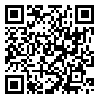Volume 15, Issue 4 (Winter 2008)
J Birjand Univ Med Sci. 2008, 15(4): 49-55 |
Back to browse issues page
Download citation:
BibTeX | RIS | EndNote | Medlars | ProCite | Reference Manager | RefWorks
Send citation to:



BibTeX | RIS | EndNote | Medlars | ProCite | Reference Manager | RefWorks
Send citation to:
Ebrahimzadeh A, Madarshahian F. Comparison of Brucellosis anti-antibody levels following treatment with Streptomycin + Doxycycline and Rifampin + Doxycycline. Journals of Birjand University of Medical Sciences 2008; 15 (4) :49-55
URL: http://journal.bums.ac.ir/article-1-376-en.html
URL: http://journal.bums.ac.ir/article-1-376-en.html
1- Assistant Professor, Department of Infectious Diseases, Faculty of Medicine, Birjand University of Medical Sciences. Birjand, Iran , a.ebrahimzadeh@yahoo.com
Abstract: (19342 Views)
Background and Aim: Brucellosis has widespread prevalence and is one of the endemic diseases in our country, Iran. It is estimated that every year almost 500000 cases of Brucellosis - mostly Brucella Melitensis-occur in the world. Any type of brucellosis demands a specific treatment. Thus, this study was conducted to compare reduction of Brucellosis anti-antibody level in the serum one year after treatment with two regimens, i.e. Streptomycin + Doxycyclin and Rifampin + Doxycyclin. Materials and Methods: This experimental study was performed on 100 patients with Brucellosis based on the clinical findings wright ≥ 1/80 and 2ME ≥ 1/80. The cases were randomly divided into two groups one received Streptomycin + Doxycyclin (50 cases), and the other group was treated by Rifampin + Doxycyclin (50 cases). Then 3, 6 and 12 months after treatment Wright and 2ME tests were performed and their results compared by means of statistics using Chi-Square test. Results: The findings of the study showed that age of the cases ranged between 13 and 78 years and 46% of them were 39-48 years old. Results of the tests revealed no significant differences before treatment ,but immediately after treatment significant differences were observed in the two groups (Wright: P=0.05, 2ME: P=0.005) as in the first group tests tended to be negative more rapidly than in the second group. Wright’s test after 3 months showed significant differences in the two groups (P= 0.05) but there were no significant differences at 6 and 12 months following treatment. Conclusion: Regarding the rapidity of negative titers of tests in the first group immediately and 3 months after treatment, it could be inferred that Streptomycin regimen leads to a more effective treatment with rapid recovery which is also accompanied by reduction in the disease anti–antibody level in the serum.
Type of Study: Original Article |
Subject:
Immunology
Received: 2009/05/12 | Accepted: 2016/03/10 | ePublished: 2016/03/10
Received: 2009/05/12 | Accepted: 2016/03/10 | ePublished: 2016/03/10
Send email to the article author
| Rights and permissions | |
 |
This work is licensed under a Creative Commons Attribution-NonCommercial 4.0 International License. |





